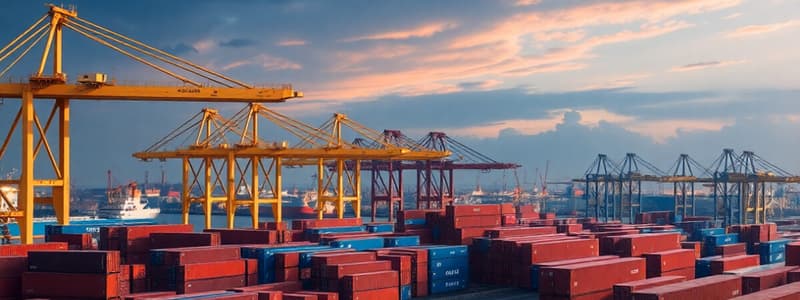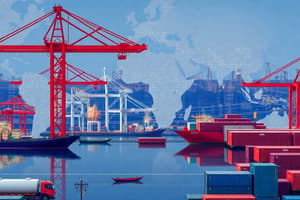Podcast
Questions and Answers
International trade refers to the exchange of goods and services across ______ borders.
International trade refers to the exchange of goods and services across ______ borders.
international
The theory that describes how countries can specialize in producing goods where they have a lower opportunity cost is known as ______ advantage.
The theory that describes how countries can specialize in producing goods where they have a lower opportunity cost is known as ______ advantage.
comparative
A ______ is a tax imposed on imports to protect domestic industries.
A ______ is a tax imposed on imports to protect domestic industries.
tariff
In economics, the study of the economy as a whole, focusing on aggregate measures, is referred to as ______.
In economics, the study of the economy as a whole, focusing on aggregate measures, is referred to as ______.
The study of psychological influences on economic decision-making is called ______ economics.
The study of psychological influences on economic decision-making is called ______ economics.
Bounded ______ refers to the limitations individuals face in obtaining complete information when making decisions.
Bounded ______ refers to the limitations individuals face in obtaining complete information when making decisions.
______ Theory explains that individuals perceive gains and losses differently, affecting their risk preferences.
______ Theory explains that individuals perceive gains and losses differently, affecting their risk preferences.
In microeconomics, the relationship between quantity supplied and quantity demanded is described by the concept of ______ equilibrium.
In microeconomics, the relationship between quantity supplied and quantity demanded is described by the concept of ______ equilibrium.
Flashcards are hidden until you start studying
Study Notes
International Trade
- Definition: Exchange of goods and services across international borders.
- Benefits:
- Comparative advantage: Countries specialize in producing goods where they have a lower opportunity cost.
- Increased market size: Access to a larger consumer base.
- Economies of scale: Reduction in costs per unit through increased production.
- Trade Policies:
- Tariffs: Taxes on imports to protect domestic industries.
- Quotas: Limits on the quantity of imports.
- Free trade agreements: Treaties between countries to reduce trade barriers (e.g., NAFTA, EU).
- Trade Theories:
- Absolute advantage: Ability of a country to produce a good more efficiently than another.
- Heckscher-Ohlin theory: Trade patterns are determined by countries' factor endowments (land, labor, capital).
Economic Theory
- Microeconomics vs. Macroeconomics:
- Microeconomics: Study of individual consumers and firms; focuses on supply and demand, price determination.
- Macroeconomics: Study of the economy as a whole; focuses on aggregate measures like GDP, unemployment, inflation.
- Key Concepts:
- Supply and Demand: The relationship between the quantity of a good available and the desire for that good.
- Market Equilibrium: Point where supply equals demand.
- Elasticity: Measurement of how much quantity demanded or supplied responds to price changes.
- Major Schools of Thought:
- Classical Economics: Emphasis on free markets and self-regulating nature of economies.
- Keynesian Economics: Advocates for government intervention in the economy to manage demand.
- Monetarism: Focus on the role of governments in controlling the amount of money in circulation.
Behavioral Economics
- Definition: Study of psychological influences on economic decision-making.
- Key Principles:
- Bounded rationality: Individuals make decisions based on limited information and cognitive limitations.
- Prospect Theory: People value gains and losses differently, leading to risk-averse or risk-seeking behaviors.
- Mental accounting: Individuals categorize and treat money differently depending on its source.
- Applications:
- Nudges: Subtle policy shifts that encourage people to make decisions that are in their broad self-interest (e.g., default options in retirement savings).
- Understanding consumer behavior: Insights into how biases influence spending, saving, and investing.
- Critiques:
- Challenges the assumption of rational agents in traditional economic models.
- Emphasizes the role of social, emotional, and cognitive factors in economic decisions.
International Trade
- Exchange of goods and services occurs across international borders.
- Benefits of international trade include:
- Comparative advantage: Countries specialize in producing goods at a lower opportunity cost, maximizing efficiency.
- Increased market size: Expanding access to a larger global consumer base enhances market opportunities.
- Economies of scale: As production increases, costs per unit decrease, benefitting producers.
- Trade Policies are essential for regulating trade:
- Tariffs: Imposed taxes on imports aimed at protecting domestic industries.
- Quotas: Established limits on the volume of specific imports allowed.
- Free trade agreements: Treaties, like NAFTA and EU, designed to minimize trade barriers and encourage trade between nations.
- Trade Theories explain the dynamics of international trade:
- Absolute advantage: A nation can produce a good more efficiently than another nation.
- Heckscher-Ohlin theory: Trade patterns depend on a country's factor endowments, such as land, labor, and capital.
Economic Theory
- Microeconomics vs. Macroeconomics:
- Microeconomics: Investigates individual consumers and firms, focusing on supply, demand, and price determination.
- Macroeconomics: Analyzes the economy as a whole, dealing with aggregate indicators like GDP, unemployment, and inflation.
- Key Concepts critical to understanding economic interactions:
- Supply and Demand: Relationship between the quantity available and the desire for a good influences market dynamics.
- Market Equilibrium: The state where supply matches demand, determining the price of goods.
- Elasticity: Indicates the responsiveness of quantity demanded or supplied relative to price changes.
- Major Schools of Thought in economics provide different perspectives:
- Classical Economics: Advocates for free markets, emphasizing the self-regulating nature of economies.
- Keynesian Economics: Supports government intervention to manage economic demand and stimulate growth.
- Monetarism: Concentrates on the government's role in controlling money supply to influence economic activity.
Behavioral Economics
- Definition: Explores how psychological factors affect economic decision-making processes.
- Key Principles that shape economic behavior:
- Bounded rationality: Decision-making is constrained by limited information and cognitive capabilities.
- Prospect Theory: Highlights how people perceive gains and losses differently, often exhibiting risk-averse or risk-seeking behavior.
- Mental accounting: Individuals categorize finances differently, affecting spending and saving behaviors based on money sources.
- Applications of behavioral economics include:
- Nudges: Policy changes that subtly encourage better decision-making aligned with individual self-interest (e.g., default options in retirement plans).
- Understanding consumer behavior: Insights reveal how biases impact financial decisions, including spending, saving, and investing.
- Critiques challenge traditional economic models:
- Questions the presumption of rational behavior in decision-making.
- Highlights the importance of social, emotional, and cognitive influences on economic choices.
Studying That Suits You
Use AI to generate personalized quizzes and flashcards to suit your learning preferences.





